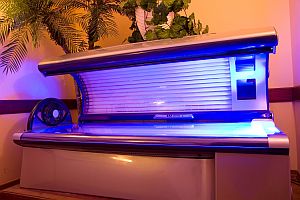Most people want to look their best all year long, but getting a nice bronze tan isn’t a healthy way to do it. The Centers for Disease Control and Prevention (CDC) reports that “A tan is a response to injury: skin cells respond to damage from UV rays by producing more pigment.” So—by definition—any tanning is the result of damage to your skin cells.
Tanning salons are a business. And as a business, they’re naturally interested in selling their products and services. However, there’s growing evidence that these products and services are actually dangerous. According to the CDC, tanning salon sessions cause roughly 1,800 emergency room visits every year. One of the problems involves the varying output of the ultraviolet (UV) light bulbs because of bulb type and age. This means that gauging the amount of time needed for a tanning visit based on the effectiveness of a prior visit can prove dangerous. Why? Because even if your previous visit was 20 minutes long, you could get far more UV damage from 20 minutes during your second visit if newer bulbs are being used.
You may hear from tanning salon employees that indoor tanning is safer than outdoor tanning, but the simple truth is that all tanning causes damage. One study found that tanning beds can expose a user to levels of cancer-causing UVAS rays that are ten times higher than what you’d get from normal sun tanning.
A 2012 report from the United States House of Representatives found that tanning salons are responsible for a great many public misconceptions about indoor tanning.
- 90% of tanning salons informed clients that tanning is perfectly safe and poses no dangers to health.
- 78% of tanning salons told clients that tanning improves health.
- 51% of tanning salons advised clients that indoor tanning does not increase skin cancer risks.
All of the above statements by tanning salons are false. According to a study published in the British medical journal, Lancet, in 2010, skin cancer caused 80,000 deaths worldwide. This is a sharp increase from 51,000 skin cancer deaths in 1990. Around the world, public health officials are convinced that tanning salons contribute to these numbers.
However, it’s also worth mentioning that the overall public health picture as it relates to tanning is more complicated. Medical researchers continue to investigate a wide range of issues. For example, a 2012 study at the Missouri University of Science and Technology investigated sunscreen and its reaction to harsh sunlight. Scientists found that the chemicals in sunscreen reacted to the ultraviolet light to create free radicals that are linked with cancer.
Another report by the World Health Organization provides worldwide statistics for skin cancer deaths. Nearly ZERO percent of skin cancer deaths occur in some of the sunniest countries in the world—those of North Africa and the Middle East. India, China and other countries have similarly low skin cancer death rates. More studies are needed before we can know for certain the direct causes of skin cancer and why countries that receive a great deal of UV rays have some of the lowest rates of skin cancer in the world.
But, whatever the broader state of research into sunlight exposure and skin cancer, people should recognize the unnecessary risks posed by sunbathing generally and tanning salons in particular.

